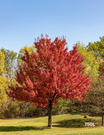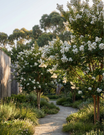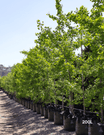If you're looking to enhance your garden with not just beauty but also a sensory experience, fragrance is a key element. Imagine stepping into your garden and being greeted by delightful, fresh, and calming scents. In addition to visual appeal, fragrant trees can transform your garden into a serene and inviting retreat. Whether you're hosting guests or simply enjoying a quiet afternoon, the right selection of aromatic trees can elevate your garden experience to new heights.
In this article, we'll explore the top three trees that offer both beauty and fragrance, perfect for Australian gardens. We’ll also provide essential planting tips to ensure these trees thrive in your landscape. Let’s delve into the best options for bringing luxury and sensory delight to your garden.
1. Murraya paniculata (Orange Jessamine)
Known for its dense, glossy green foliage and intoxicating scent, Murraya paniculata, commonly referred to as Orange Jessamine or Mock Orange, is an exceptional choice for any garden seeking elegance and aroma. Native to tropical Asia and Australia, this tree can also be pruned into a hedge or left to grow naturally, making it highly versatile.
Why It’s Perfect for Your Garden:
- Fragrance: The sweet, citrusy fragrance of Orange Jessamine is one of its most prized features. Its white, jasmine-like flowers bloom several times a year, particularly after rain, ensuring a regular infusion of fragrance in your garden.
- Appearance: With its small, glossy leaves and clusters of white flowers, Murraya paniculata adds a touch of sophistication to any landscape.
- Adaptability: This tree is well-suited to both formal and informal gardens. It’s drought-tolerant, making it ideal for the Australian climate, especially in warmer regions.
Planting Tips:
- Position: Plant Murraya paniculata in full sun to partial shade. It prefers well-drained, fertile soil but can adapt to different types of soils.
- Care: This tree requires little maintenance but thrives with occasional pruning and deep watering during dry periods.
- Size: It can grow up to 3-4 meters, making it ideal for hedging or as a standalone feature.
Garden Benefits:
- It acts as a privacy screen or windbreak.
- Continuous blooms provide fragrance throughout the year.
2. Magnolia grandiflora (Southern Magnolia)
For those who appreciate grandeur and fragrance, Magnolia grandiflora, also known as Southern Magnolia, is an exquisite addition to any garden. This tree is renowned for its large, creamy white flowers and rich, lemony scent that fills the air during its blooming season.
Why It’s Perfect for Your Garden:
- Fragrance: The large, cup-shaped flowers emit a fresh, citrusy scent, creating an atmosphere of pure luxury.
- Appearance: Magnolia grandiflora is majestic with its glossy, dark green leaves and massive white blooms, some of which can reach up to 30cm in diameter. It’s a statement tree that can be a focal point in any garden.
- Longevity: Magnolias are known for longevity, meaning they’ll be a lasting feature in your landscape for years.
Planting Tips:
- Position: This tree loves full sun to partial shade. While it prefers rich, well-drained soil, it’s fairly adaptable to different conditions.
- Care: Once established, Magnolia grandiflora is relatively low-maintenance, requiring deep, infrequent watering. Regular mulching helps retain moisture and keep roots cool.
- Size: It can grow quite tall, reaching 10-25 meters, but compact varieties like 'Little Gem' offer a more manageable option for smaller gardens.
Garden Benefits:
- Attracts birds and pollinators.
- Offers stunning year-round foliage and beautiful, fragrant flowers during spring and summer.
3. Backhousia citriodora (Lemon Myrtle)
Consider Backhousia citriodora, commonly known as Lemon Myrtle for a more unique and distinctly Australian fragrance. This native Australian tree is prized for its strong lemon-scented leaves and aromatic white flowers, adding an energizing citrus note to your garden.
Why It’s Perfect for Your Garden:
- Fragrance: As the name suggests, Backhousia citriodora produces a refreshing lemon fragrance that is released from both its leaves and flowers. This invigorating scent lingers throughout the garden, creating a fresh, clean atmosphere.
- Appearance: This evergreen tree features glossy green leaves and clusters of small white flowers that bloom in late spring to summer, adding both visual and olfactory appeal.
- Culinary Uses: Beyond fragrance, Lemon Myrtle is also renowned for its culinary value. Its leaves are often used in teas, desserts, and savory dishes, making it a delightful and functional addition to your garden.
Planting Tips:
- Position: Plant Backhousia citriodora in full sun or partial shade. It prefers well-drained soils, particularly those rich in organic matter.
- Care: Lemon Myrtle is relatively low-maintenance but benefits from regular watering, especially during dry periods. Light pruning helps maintain its shape and encourages denser growth.
- Size: In ideal conditions, it can grow up to 6 meters, though it’s easily kept smaller through pruning.
Garden Benefits:
- Attracts beneficial insects, such as bees and butterflies.
- The leaves can be harvested for culinary use.
- It provides a distinctive, fresh fragrance unique to Australian native gardens.
Essential Tree-Planting Tips for a Fragrant Garden
Creating a garden that’s alive with beautiful scents involves more than just picking the right trees. To ensure your fragrant trees thrive, follow these essential tips:
- Soil Preparation: Use nutrient-rich, well-draining soil. Before planting, consider adding organic matter to improve soil quality.
- Watering: Trees require deep watering, especially during dry periods—water at the base to encourage deep root growth.
- Pruning: Regular pruning helps shape the tree and promote healthy flowering. For trees like Murraya paniculata, pruning encourages denser, fuller growth, perfect for hedges.
- Mulching: Apply a layer of mulch around the base of your trees to retain moisture and protect the roots from temperature fluctuations.
- Placement: Plant fragrant trees near patios, walkways, or windows where the fragrance can be enjoyed regularly.
FAQs
1. Which fragrant tree is best for small gardens?
For smaller gardens, consider Murraya paniculata or a dwarf variety of Magnolia grandiflora like ‘Little Gem.’ Both provide fragrance without taking up too much space.
2. Are these trees suitable for Australian climates?
All the trees mentioned—Murraya paniculata, Magnolia grandiflora, and Backhousia citriodora—are well-suited to Australia’s climate. They thrive in various regions, with some preferring warmer climates.
3. Can I use Lemon Myrtle leaves in cooking?
Absolutely! Backhousia citriodora is a popular culinary choice. Its lemon-scented leaves can be used in teas, desserts, and various savory dishes.
Incorporating fragrant trees into your garden not only enhances its visual appeal but also adds a sensory experience that elevates the overall ambiance. Whether it’s the citrus notes of Murraya paniculata, the lemon freshness of Backhousia citriodora, or the luxurious scent of Magnolia grandiflora, these trees will enrich your garden and create a space where nature’s beauty and fragrance come together.


















































Leave a comment
This site is protected by hCaptcha and the hCaptcha Privacy Policy and Terms of Service apply.